(完整版)动词的被动语态
- 格式:doc
- 大小:32.50 KB
- 文档页数:5

动词的被动语态①I often see her going shopping.→The school set up a special class to help poor readers.→②He made the machine yesterday.→The children gave the foreign guests a warm welcome.→③We will finish the work tomorrow.→I will send my second boy to school next September→④The workers are repairing the main building of the school.→They are disscussing the question in the room→⑤I was washing dishes at that time.→⑥We have finished the work.→Many countries have sent up satellites into space.→⑦We had cancelled the meeting before he arrived.→He had cleaned the room before I came back.→⑧We will have learned 1000 words by next term.→⑨He said that they would build the bridge next year→▲含情态动词的被动结构:情态动词+be+doneWe can repair this watch in two days.→We should do the work as soon as possible.→You must pay attention to your pronunciation→1) 被动语态的一般疑问句是将一个Be动词置于主语之前;( Does Kate sometimes break glasses? → The glasses are sometimes broken by Kate.→Are the glasses sometimes broken by kate? )Do you always send a letter to Mr Hu?→Did he clean the blackboard just now?→2)否定句是在第一个助动词后加not;He doesn't show the stamps to me.→He didn't give the dictionary to me yesterday.→●Nobody can answer this question. →The question can be answered by nobody. ()The question can not be answered by anybody. ( ) Nobody can throw the rubbish everywhere.→●They haven't done anything to make the river clean.→Anything hasn't been done to make the river clean. ()Nothing has been done to make the river clean. ()He didn’t bring anything to me .→3)特殊疑问句的语序为:疑问词+一般疑问句。
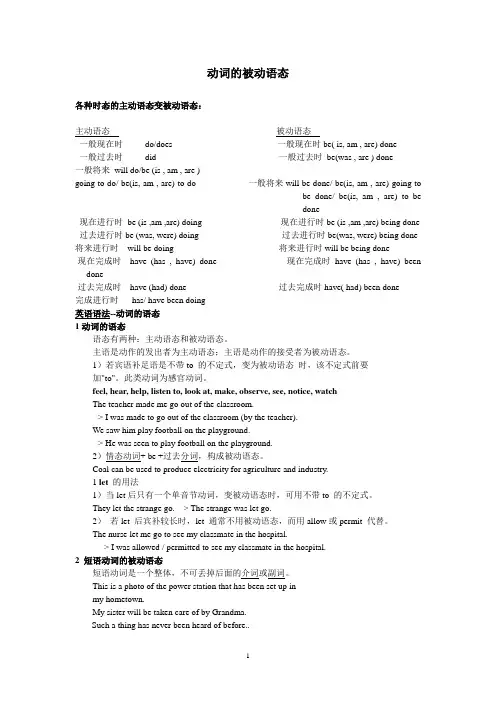
动词的被动语态各种时态的主动语态变被动语态:主动语态被动语态一般现在时do/does 一般现在时be( is, am , are) done一般过去时did 一般过去时be(was , are ) done一般将来will do/be (is , am , are )going to do/ be(is, am , are) to do 一般将来will be done/ be(is, am , are) going tobe done/ be(is, am , are) to bedone现在进行时be (is ,am ,are) doing 现在进行时be (is ,am ,are) being done 过去进行时be (was, were) doing 过去进行时be(was, were) being done 将来进行时will be doing 将来进行时will be being done现在完成时have (has , have) done 现在完成时have (has , have) been done过去完成时have (had) done 过去完成时have( had) been done完成进行时has/ have been doing英语语法--动词的语态1动词的语态语态有两种:主动语态和被动语态。
主语是动作的发出者为主动语态;主语是动作的接受者为被动语态。
1)若宾语补足语是不带to 的不定式,变为被动语态时,该不定式前要加"to"。
此类动词为感官动词。
feel, hear, help, listen to, look at, make, observe, see, notice, watchThe teacher made me go out of the classroom.--> I was made to go out of the classroom (by the teacher).We saw him play football on the playground.--> He was seen to play football on the playground.2)情态动词+ be +过去分词,构成被动语态。

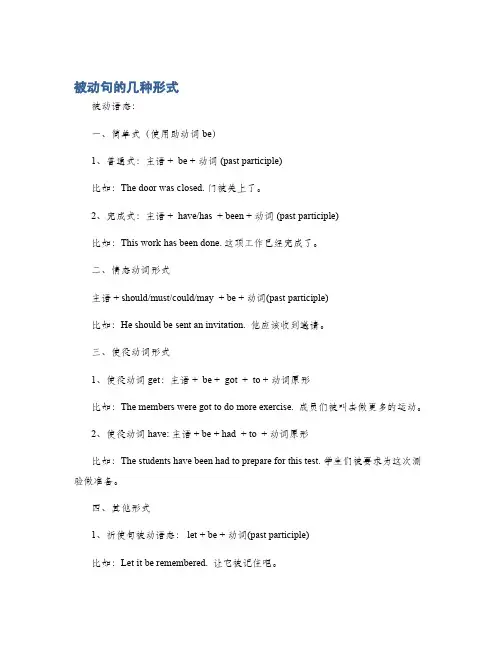
被动句的几种形式被动语态:一、简单式(使用助动词be)1、普通式:主语 + be + 动词 (past participle)比如:The door was closed. 门被关上了。
2、完成式:主语 + have/has + been + 动词 (past participle)比如:This work has been done. 这项工作已经完成了。
二、情态动词形式主语 + should/must/could/may + be + 动词(past participle)比如:He should be sent an invitation. 他应该收到邀请。
三、使役动词形式1、使役动词 get:主语 + be + got + to + 动词原形比如:The members were got to do more exercise. 成员们被叫去做更多的运动。
2、使役动词 have: 主语 + be + had + to + 动词原形比如:The students have been had to prepare for this test. 学生们被要求为这次测验做准备。
四、其他形式1、祈使句被动语态: let + be + 动词(past participle)比如:Let it be remembered. 让它被记住吧。
2、there+ be 结构:there + be + 主语 + 动词(past participle)比如:There was an earthquake yesterday. 昨天发生了一次地震。
3、it 作形式主语+be+done: it + be + done + that + 句子比如:It is said that the environment is being seriously polluted. 据说环境受到严重污染。
随着社会的发展,被动语态功能的使用越来越普遍,它不仅可以强调动作本身,也可以强调说话者关注的对象。
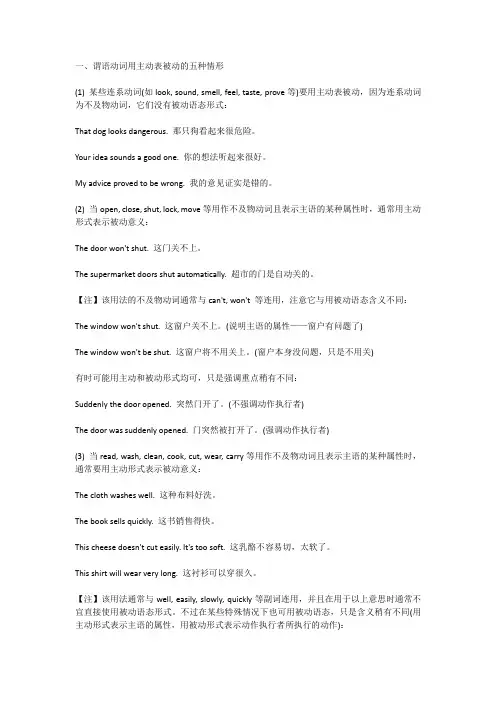
一、谓语动词用主动表被动的五种情形(1) 某些连系动词(如look, sound, smell, feel, taste, prove等)要用主动表被动,因为连系动词为不及物动词,它们没有被动语态形式:That dog looks dangerous. 那只狗看起来很危险。
Your idea sounds a good one. 你的想法听起来很好。
My advice proved to be wrong. 我的意见证实是错的。
(2) 当open, close, shut, lock, move等用作不及物动词且表示主语的某种属性时,通常用主动形式表示被动意义:The door won't shut. 这门关不上。
The supermarket doors shut automatically. 超市的门是自动关的。
【注】该用法的不及物动词通常与can't, won't 等连用,注意它与用被动语态含义不同:The window won't shut. 这窗户关不上。
(说明主语的属性——窗户有问题了)The window won't be shut. 这窗户将不用关上。
(窗户本身没问题,只是不用关)有时可能用主动和被动形式均可,只是强调重点稍有不同:Suddenly the door opened. 突然门开了。
(不强调动作执行者)The door was suddenly opened. 门突然被打开了。
(强调动作执行者)(3) 当read, wash, clean, cook, cut, wear, carry等用作不及物动词且表示主语的某种属性时,通常要用主动形式表示被动意义:The cloth washes well. 这种布料好洗。
The book sells quickly. 这书销售得快。
This cheese doesn't cut easily. It's too soft. 这乳酪不容易切,太软了。
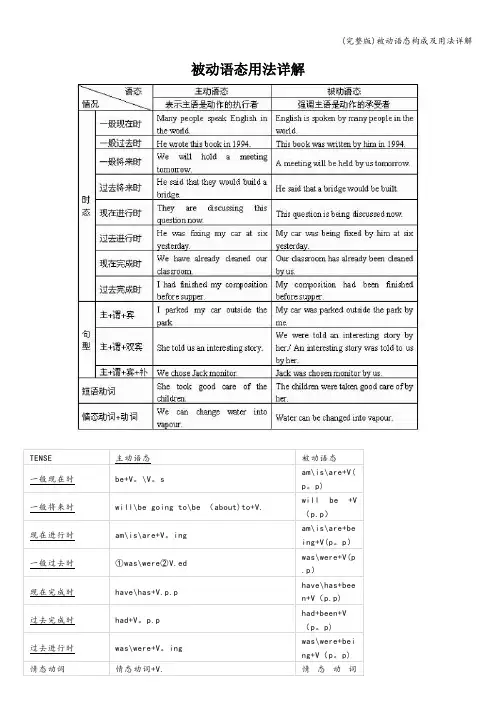
被动语态用法详解TENSE主动语态被动语态一般现在时be+V。
\V。
s am\is\are+V( p。
p)一般将来时will\be going to\be (about)to+V.will be +V (p.p)现在进行时am\is\are+V。
ing am\is\are+be ing+V(p。
p)一般过去时①was\were②V.ed was\were+V(p .p)现在完成时have\has+V.p.p have\has+bee n+V(p.p)过去完成时had+V。
p.p had+been+V (p。
p)过去进行时was\were+V。
ing was\were+bei ng+V(p。
p)情态动词情态动词+V.情态动词被动语态牢记一点,be加动词过去分词。
分析句中主和谓,承受者作主语即被动。
短语动词不可忘介、副词。
另有不及物动词,只有主动无被动.还要注意其时态,与主动语态全相同.不用被动语态的情况1)不及物动词或动词短语无被动语态(即多数的瞬间动词):appear, die(死亡),disappear (消失), end (vi. 结束), fail, happen, last, lie, remain, sit, spread, stand break out, come true, fall asleep, keep silence, lose heart, take place. After the fire, very little remained of my house。
比较: rise, fall, happen是不及物动词;raise, seat是及物动词。
(错)The price has been risen.(对)The price has risen。
(错)The accident was happened last week.(对)The accident happened last week。
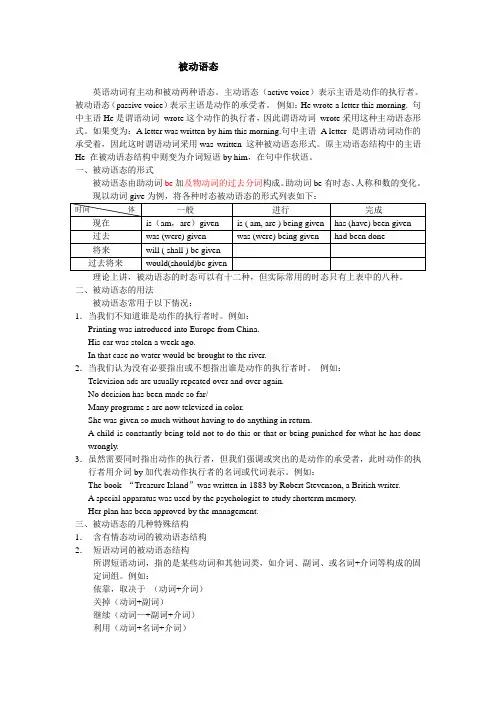
被动语态英语动词有主动和被动两种语态。
主动语态(active voice)表示主语是动作的执行者。
被动语态(passive voice)表示主语是动作的承受者。
例如:He wrote a letter this morning. 句中主语He是谓语动词wrote这个动作的执行者,因此谓语动词wrote采用这种主动语态形式。
如果变为:A letter was written by him this morning.句中主语A letter 是谓语动词动作的承受着,因此这时谓语动词采用was written 这种被动语态形式。
原主动语态结构中的主语He 在被动语态结构中则变为介词短语by him,在句中作状语。
一、被动语态的形式被动语态由助动词be加及物动词的过去分词构成。
助动词be有时态、人称和数的变化。
现以动词give为例,将各种时态被动语态的形式列表如下:理论上讲,被动语态的时态可以有十二种,但实际常用的时态只有上表中的八种。
二、被动语态的用法被动语态常用于以下情况:1.当我们不知道谁是动作的执行者时。
例如:Printing was introduced into Europe from China.His car was stolen a week ago.In that case no water would be brought to the river.2.当我们认为没有必要指出或不想指出谁是动作的执行者时。
例如:Television ads are usually repeated over and over again.No decision has been made so far/Many programe s are now televised in color.She was given so much without having to do anything in return.A child is constantly being told not to do this or that or being punished for what he has donewrongly.3.虽然需要同时指出动作的执行者,但我们强调或突出的是动作的承受者,此时动作的执行者用介词by加代表动作执行者的名词或代词表示。
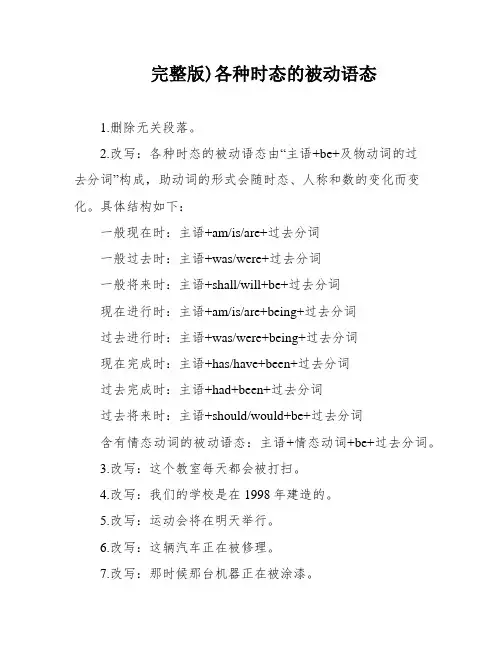
完整版)各种时态的被动语态1.删除无关段落。
2.改写:各种时态的被动语态由“主语+be+及物动词的过去分词”构成,助动词的形式会随时态、人称和数的变化而变化。
具体结构如下:一般现在时:主语+am/is/are+过去分词一般过去时:主语+was/were+过去分词一般将来时:主语+shall/will+be+过去分词现在进行时:主语+am/is/are+being+过去分词过去进行时:主语+was/were+being+过去分词现在完成时:主语+has/have+been+过去分词过去完成时:主语+had+been+过去分词过去将来时:主语+should/would+be+过去分词含有情态动词的被动语态:主语+情态动词+be+过去分词。
3.改写:这个教室每天都会被打扫。
4.改写:我们的学校是在1998年建造的。
5.改写:运动会将在明天举行。
6.改写:这辆汽车正在被修理。
7.改写:那时候那台机器正在被涂漆。
8.改写:这家银行已经建成了。
9.改写:在我来这里之前,我已经被邀请去日本访问了。
10.改写:XXX告诉我她将会被派往美国。
11.改写:这辆自行车不能放在这里。
I XXX invited so far。
so I'm not sure。
The government in our country will now record tourists' bad r。
It is XXX。
Special passive voice forms:1.When a sense verb (XXX) or a causative verb(make/let/have) is followed by an infinitive without "to" in an active sentence。
the "to" should be added in a passive sentence。
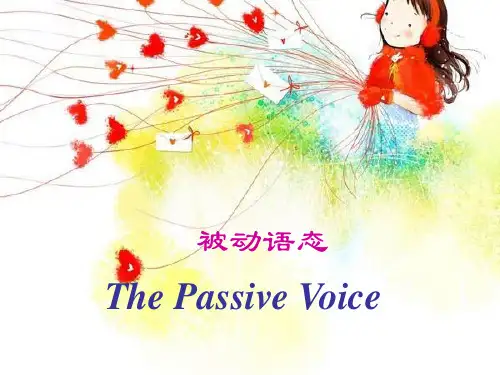
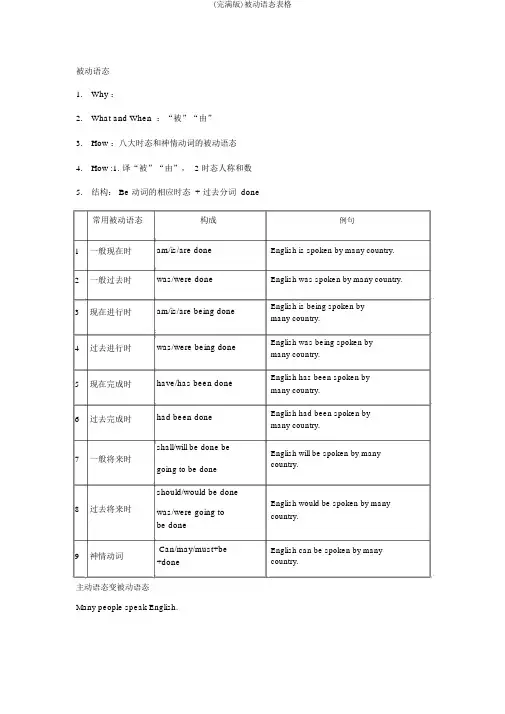
被动语态1.Why :2.What and When :“被”“由”3.How :八大时态和神情动词的被动语态4.How :1. 译“被”“由”, 2 时态人称和数5.结构: Be 动词的相应时态 + 过去分词 done常用被动语态构成例句1一般现在时2一般过去时3现在进行时4过去进行时5现在完成时6过去完成时7一般将来时8过去将来时9神情动词主动语态变被动语态am/is/are donewas/were doneam/is/are being donewas/were being donehave/has been donehad been doneshall/will be done begoing to be doneshould/would be donewas/were going tobe doneCan/may/must+be+doneEnglish is spoken by many country.English was spoken by many country.English is being spoken bymany country.English was being spoken bymany country.English has been spoken bymany country.English had been spoken bymany country.English will be spoken by manycountry.English would be spoken by manycountry.English can be spoken by manycountry.Many people speak English.1.将主句中的宾语变被动语态主语,若是是代词将代词宾格变主格,变被动语态中宾语用 by 引导,若是主语时代词由主格变宾格。
语态形式。
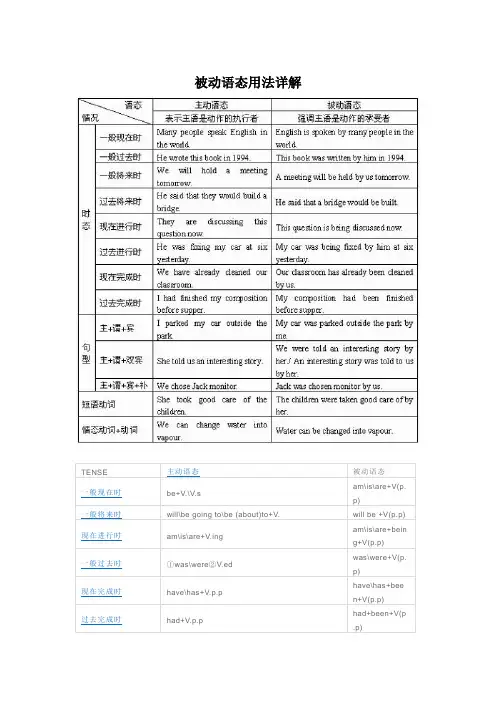
被动语态用法详解TENSE 主动语态被动语态一般现在时be+V.\V.sam\is\are+V(p.p)一般将来时will\be going to\be (about)to+V. will be +V(p.p) 现在进行时am\is\are+V.ingam\is\are+being+V(p.p)一般过去时①was\were②V.edwas\were+V(p.p)现在完成时have\has+V.p.p have\has+bee n+V(p.p)过去完成时had+V.p.phad+been+V(p.p)被动语态牢记一点,be加动词过去分词。
分析句中主和谓,承受者作主语即被动。
短语动词不可忘介、副词。
另有不及物动词,只有主动无被动。
还要注意其时态,与主动语态全相同。
不用被动语态的情况1)不及物动词或动词短语无被动语态(即多数的瞬间动词):appear, die(死亡),disappear(消失), end (vi. 结束), fail, happen, last, lie, remain, sit, spread, stand break out, come true, fall asleep, keep silence, lose heart, take place. After the fire, very little remained of my house. 比较:rise, fall, happen是不及物动词;raise, seat是及物动词。
(错)The price has been risen.(对)The price has risen.(错)The accident was happened last week.(对)The accident happened last week.(错)The price has raised.(对)The price has been raised.(错)Please seat.(对)Please be seated.要想正确地使用被动语态,就须注意哪些动词是及物的,哪些是不及物的。
动词的被动语态结构:1. be +done一般现在时am/is/are +done 一般过去时was/were +done一般将来时will +be +done 现在完成时have/has +been +done现在进行时am/is/are + being + done 情态动词+ be +及物动词的过去分词注意点:1.只有及物动词有被动语态, 不及物动词happen, take place, appear, disappear, break down和连系动词look, feel, smell, sound, get, turn等不能构成被动语态.2.变为被动语态,不能丢掉尾巴上的介词,常用的有look after, take care of, cut down, laugh at, talk about, turn on等eg. He always takes care of the little girl. →The little girl is always taken care of by him.3.有些动词短语有固定接法,接人时不用再加by,常用的有:be covered with; be surprised at; be interested in; be worried about; be made of/from; be known to4.某些动词形式是主动语态,但含有被动的意思.eg. This dictionary sells well. This kind of car drives fast.The woolen sweater costs $ 88.That car needs repairing.= That car needs to be repaired.5. 主动语态中有些动词如:make, see, listen, watch, feel后常跟不带to的动词不定式作宾语补足语,变为被动语态要带上to. 如:He made the boy work for him.→The boy was made to work for him.6.主动语态中若有双宾语(give sb. sth.; show sb. sth; pass sb. sth等),变为被动语态时注意:His uncle gave him a dictionary yesterday. →He was given a dictionary by his uncle yesterday. →A dictionary was given to him by his uncle yesterday练习题:一、把下列句子变为被动句:1.They asked me to come a little later. →I _________ _________ ________ come a little later.2.Women often talk about food and clothes. →Food and clothes _________ often __________ ________ by women.3.Do they make this kind of truck in Nanjing? → _________this kind of truck _________ in Nanjing?4.We must clean o ur teeth twice a day. →Our teeth must _________ _________ twice a day.5.Can I answer this question in simple English? →_________this question ________ ________ in simple English?6They have planted 400 trees so far. → 400 trees _______ _______ ________ by _______ so far.7.We don’t use brooms for sweeping the floor. → Brooms_________ _________for sweeping the floor.8. They made us wait at the gate. → We _______ _______ _______ _______ at the gate.9. Y ou must not put the bike there. → The bike ________ _______ _________there.10. Y ou should speak to the old politely. → The old ________ ________ _________ ________ politely.11. Where did you take these photos? → Where _______ these photos ________ ?12. Who wrote the novels? → _________ ________ the novels _________ __________?13. Y ou shouldn’t dig a hole here. → A hole ________ ________ _______ here.14. Must we hand in the homework right now? → _______ our homework _________ ________ _______ right now?15. Did he give us any magazines? → ________ we _________ any magazines _______ ________?→ _________ any magazines _________ _________ _________ by him?二、动词填空。
英语被动语态总结与练习一、被动语态的构成形式1. 被动语态的基本时态变化被动语态通常为十种时态的被动形式, 被动语态由“be+过去分词”构成,be随时态的变化而变化。
以do为例,各种时态的被动语态形式为:1) am/is/are +done (过去分词) 一般现在时Visitors are requested not to touch the exhibits.2) has /have been done 现在完成时All the preparations for the task have been completed, and we're ready to start.3) am/is /are being done 现在进行时 A new cinema is being built here.4) was/were done 一般过去时I was given ten minutes to decide whether I should reject the offer.5) had been done 过去完成时By the end of last year, another new gymnasium had been completed in Beijing.6) was/were being done 过去进行时 A meeting was being held when I was there.7) shall/will be done 一般将来时Hundreds of jobs will be lost if the factory closes.8) should/would be done 过去将来时The news would be sent to the soldier's mother as soon as it arrived.9) shall/will have been done 将来完成时(少用)The project will have been completed before July.10) should/would have been done 过去将来完成时(少用)He told me that his new clothes would have been made very soon.2. 被动语态的特殊结构形式1) 带情态动词的被动结构。
动词的被动语态一。
被动语态构成be+done一般现在时am/is/are+done一般过去时was/were +done一般将来时will/shall/be going to +be done完成时have/has/had been done进行时be being done不及物动词不用被动语态:happen, take place, occur, break out正确理解各种常见时态的被动语态被动语态表示主语是动作的承受着.例如The old doctor is respected by everyone.被动语态谓语动词be+及物动词的过去分词.被动语态共有十种时态. 以动词tell为例,其被动语态的各种时态构成如下:下面以往届高考题中出现的被动语态为例说明其具体用法.一般现在时(MET1993.30)答案: B. 在世界上一些地区,茶里放有牛奶和糖一起(被)供应.一般过去时:答案: C从句中”This ia Ted’s photo. We miss him a lot.”可知Ted 已经死了,因此”kill”应为过去的动作,而且是被动语态.现在进行时: (2001春招, 17)答案: D. 从后面的提示看,这项工程还没有完工,故应正在建设中,而且是被动语态,故答案为D.一般将来时:(2001春招,15)Hundreds of jobs________if the factory closes.A. loseB.are lostC.will be lostD.will lose答案: C此题中包含一个if引导的条件状语从句,从句用现在时代替将来时,因此主句应用一般将来时,而且句意为被动, 故答案为C.二.不同句型的被动语态1.双宾语的被动语态eg. I give my brother a computer.Sb间接宾语sth直接宾语A: My brother is given a computer by me.B: A computer is given to my brother.2.复合宾语的被动语态eg.We call him Lao Li.= He is called Lao Li by us.She told me to wait for you.=I was told to wait for you by her.3.感官动词和使役动词(let/make/have)的被动语态1).The boss made his workers work 15 hours each day.The workers were made to work 15 hours each day(bu the boss).2).I saw a child cross the road alone.A child was seen to cross the road alone.4.情态动词的被动语态情态动词+be + done1). We can turn solids into liquids.Solids can be turned into liquids.2).You must not leave the bike here.The bike must not be left here.5.动词短语的被动语态必须注意动词短语的完整性eg. They take a good care of the children.The children are taken a good care of.A good care is taken of the children.类似的短语还有:pay attention to, make use of etc.三。
一.被动语态的时态:1.一般现在时的被动语态:am /is/ are +动词的过去分词2.一般过去时的被动语态:was /were +动词的过去分词3.一般将来时的被动语态:will be +动词的过去分词4.现在进行时的被动语态:am /is /are +being +动词的过去分词5.现在完成时的被动语态:have /has +been +动词的过去分词6.情态动词的被动语态:情态动词+ be +动词的过去分词二.主动语态变被动语态的变法:口诀:宾变主,主变宾,谓变be done ,时不变,数格必须随被变。
注:1.主动、被动的时态要一致。
2.主动、被动的句式要一致。
3.变成的被动语态的主语与谓语在单复数上保持一致。
三.特殊情况的被动语态:1.带双宾语的被动语态:动词+ sb(间宾) +sth(直宾)口诀:如遇双宾语,一般变间宾,若把直宾变,to /for 间宾连。
1).give/pass /show 与介词to 搭配。
give sb sth ——sb +be given sth 或sth +be given +to sb .2).buy/make/cook 与介词for 搭配。
buy sb sth ——sb +be bought + sth 或sth +be bought +for sbHe gave me a bookI ______ ______ a book by him.A book ____ ____ _____ me by him .My mother made me a cake .A cake ____ ____ ____ me by my mother .2.带省to 的不定式作宾补的被动语态:动词+ sb + do sth .口诀:感使动词真叫怪,to来to去记心怀,主动语态to离去,被动语态to回来。
动词:make / let /have /see /hear /feel /watch/noticemake sb do sth ----sb + be +made +to do sthThe boss made the workers work all dayThe workers ____ ____ ____ work all day by the boss.3.在see /hear /notice /keep +sb +doing sth 句型中变被动语态时,doing 不变。
动词的被动语态
一.被动语态的构成或用法
(一)被动语态的构成
1.被动语态的基本机构:be+动词的过去分词
2.各种时态的主动、被动语态的构成如下:
一般现在时--- 主动:do/does 被动:am/is/are+done
We clean the classroom. The classroom is cleaned by us.
一般过去时--- 主动:did 被动:was/were+done
He made the kite. The kite was made by him.
现在进行时--- 主动:am/is/are+doing被动:am/is/are+being done She is watering flowers. Flowers are being watered by her.
现在完成时--- 主动:have/has+done被动:have/has+been done
Jim has finished the work. The work has been finished by Jim.
一般将来时--- 主动:will/shall/be going to do 被动:will/shall/be going to be done
They will plant trees tomorrow. Trees will be planted by them tomorrow. 过去进行时--- 主动:was/were doing 被动:was/were+being done She was writing a letter this time yesterday. A letter was being written by her this time yesterday.
过去完成时--- 主动:had+done 被动:had+been done
Jim had finished the work. The work had been finished by Jim.
过去将来时--- 主动:would/should/be going to do 被动:
would/should/be going to be done
He said he would make a kite. He said a kite would be made by him.
含有情态动词--- 主动:can/may/must do 被动:can/may/must be done
I can find him. He can be found by me.
(二) 被动语态的用法
在被动语态中,主语是动作的承受者,主要用于下列情况:
1.不知道动作的执行者是谁。
This watch is made in China.
2. 没有必要指出动作的执行者是谁。
More trees must be planted every year.
3. 需要强调或突出动作的承受者。
Chinese is spoken by more and more people in the world.
4. 动作的发出者不是指认。
Many houses were washed away in the flood.
二.主动语态和被动语态的转换
(一)主动语态变为被动语态
1.要将主动句中的宾语变为被动句中的主语,若主动句中的宾语
是人称代词,要将宾格变为主格。
2.把主动句中的主语变为被动句中的宾语,主格变为宾格,并由
by引导。
3.谓语动词变成相应的被动形式。
We asked him to sing an English song.
He was asked to sing and English song by us.
(二)带双宾的谓语动词变为被动语态
谓语动词带双宾时,既可以将间接宾语转化为主语,也可以将直接宾语转化成主语。
若将间接宾语转化成主语,则保留直接宾语;若将直接宾语转化成主语则保留间接宾语,且在被保留间接宾语前加上介词to或for. She gave me a book. I was given a book by her.
A book was give to me by her.
(三)短语动词变为被动语态
许多由不及物动词构成的短语动词,相当于及物动词,可以有宾语,也可以有被动语态。
注意:短语动词是一个不可分割的整体,在变为被动语态时,不可丢掉构成短语动词的介词或副词。
We should take good care of the children.
The children should be taken good care of.(of不可省略)
(四) 带复合宾语的动词变为被动语态
宾语加上宾补一起构成复合宾语。
变被动语态时,只把宾语变为被动句的主语,宾语补足语保留在原处,成为主语补足语。
I saw some boys playing football on the playground.
Some boys were playing football on the playground.
(五) 被动语态后动词形式的选择。
主动句中的感官动词see, hear, watch, feel, notice等和使役动词let, make, have等后跟省略to的不定式,变为被动语态时,应加上不定式符号to。
We often hear the girl sing in her room n the evening.。